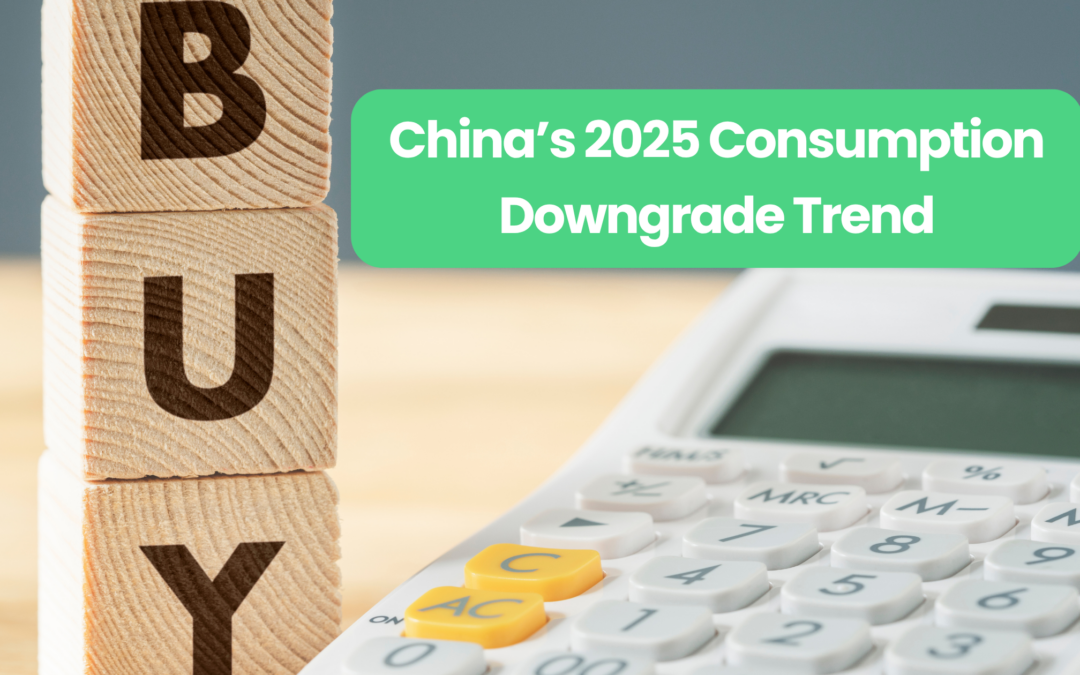In 2025, China’s consumption downgrade is driving a profound structural transformation in the country’s consumer market. According to the National Bureau of Statistics, total retail sales of consumer goods grew by just 0.8% in Q1 2025, with spending in 30 major cities nearly halved.
The so-called China’s consumption downgrade is no longer simply about consumers having less money—it’s about them becoming more rational, more selective, and more focused on real value. In this new landscape, luxury brands are seeing a decline, premium pricing is losing appeal, while second-hand markets, value-for-money products, and immersive consumption experiences are on the rise.
To stay competitive, brands must deeply understand these shifts in consumer behavior. Success will depend on their ability to proactively adapt strategies, pricing models, customer service, and channel approaches to meet the evolving expectations of Chinese consumers.
1. Price Transparency: Brands Must Return to Real Value in China
In today’s hyper-connected Chinese market, price transparency is no longer optional—it’s a strategic imperative. With the widespread use of social media, cross-border e-commerce, and price comparison tools, Chinese consumers are more informed and price-sensitive than ever. The days of relying on information asymmetry to justify high markups are quickly fading.
Case in Point: Häagen-Dazs—Luxury No More
Once dubbed the “LV of ice cream,” Häagen-Dazs has seen a sharp decline in China. Its store count has dropped to 385, and foot traffic continues to shrink. A key reason? Chinese consumers discovered that Häagen-Dazs products are significantly more expensive in China than in the U.S. or Japan. For example:
- A 75g mini cup costs ¥43 in China.
- In the U.S., an 828g tub sells for just $5.99—and often with promotions.
This stark price gap, once hidden, is now easily exposed in the age of digital transparency. The result? A damaged brand image and eroded consumer trust.
Strategic Takeaway
Brands must move beyond the outdated mindset of premium pricing based on opacity. Instead, they should:
- Align global pricing strategies to avoid perceptions of price discrimination.
- Emphasize product authenticity and value.
- Build long-term trust through consistency and fairness.

2. Service Experience: The New “Must-Have” in China’s Consumer Market
Today’s Chinese consumers are no longer swayed by brand prestige alone—they’re driven by the quality of experience. From store layout to service details and emotional connection, “experience value” has become a non-negotiable.
Case Study: Pangdonglai—Closing Profitable Stores to Protect Brand Experience
Pangdonglai, a local retail chain in Henan known for its exceptional service, made headlines in 2025 by closing several profitable but outdated stores. Founder Yu Donglai explained, “Even though these stores are making money, they no longer reflect the quality we want to deliver.” This bold move underscores a shift in focus—from expansion to experience elevation.
Strategic Insight
China’s consumption downgrade doesn’t mean consumers want cheap—it means they want value. Brands must:
- Rethink store design and customer flow.
- Elevate service touchpoints and ambiance.
- Create immersive, emotionally resonant shopping experiences.
An Expansion Project in China? We Can Help You!
3. Practicality Over Prestige: Chinese Consumers Are Redefining Value
In today’s China, value is no longer defined by collectibility or speculative potential. As the housing market cools and financial leverage contracts, consumers are shifting away from “investment-grade” consumption and returning to practicality and real utility.
Case Study: Moutai—From Financial Asset to Everyday Luxury
Moutai, one of China’s most iconic liquor brands, has long been associated with prestige and investment value. But in recent years, the brand has actively moved to “de-financialize” its image and reposition itself as a premium yet consumable product. In 2025, Moutai launched a more accessible 1L version of its flagship Feitian Moutai on its official platform “iMoutai.” This SKU is easier to purchase and more affordably priced, helping the brand reconnect with everyday consumers and boost platform engagement.
Strategic Insight
Brands must recognize that China’s consumption downgrade is pushing consumers to seek:
- Transparent, fair pricing that reflects real value.
- Products that are accessible, not aspirationally out of reach.
- A sense of “worth it” rather than “just expensive.”
4. The Rise of the Second-Hand Economy: Rational Spending Fuels Luxury Resale Boom in China
As Chinese consumers embrace more rational and value-driven spending habits, the second-hand economy—especially in luxury goods—is experiencing explosive growth. Buying “pre-owned” is no longer seen as a compromise, but rather a smart, sustainable, and stylish choice.
Case Study: Zhuanzhuan—Second-Hand, First-Class
Zhuanzhuan, one of China’s leading resale platforms, opened its flagship 3,000-square-meter “Super Zhuanzhuan” store in Beijing’s CBD in June 2025. The store features over 30,000 SKUs, with luxury handbags from Louis Vuitton, Chanel, Hermès, and YSL taking center stage. Customers can browse, touch, and try on items—bringing tangibility and trust to the second-hand experience.
Meanwhile, Alibaba’s Xianyu continues to expand its product categories and offline presence, promoting circular consumption and reshaping perceptions of second-hand shopping.
Strategic Insight
In the context of China’s consumption downgrade, second-hand is no longer a “budget” option—it’s a “better” option. For brands, this opens up new strategic pathways:
- Certified Pre-Owned Programs: Launch official resale channels to control quality and pricing.
- Platform Partnerships: Collaborate with trusted resale platforms like Zhuanzhuan or Xianyu to reach younger, sustainability-conscious consumers.
- Circular Branding: Embrace the circular economy as part of your brand narrative, reinforcing values of longevity, authenticity, and environmental responsibility.
Conclusion: China’s Consumption Downgrade Is a Catalyst for Brand Reinvention
China’s consumer market is entering a new era—one defined not by declining purchasing power, but by rising consumer discernment. China’s consumption downgrade reflects a deeper shift: consumers are more rational, more value-conscious, and more focused on real experiences. They are no longer willing to pay for unjustified premiums.
The age of “brand alone wins” is over. In the future, the brands that succeed in China will be those that:
- Truly understand evolving consumer needs,
- Respect the shift toward practical, experience-driven consumption,
- And consistently deliver authentic, tangible value.
This is not just a challenge—it’s a rare opportunity to redefine what a brand truly means in the eyes of Chinese consumers.
Want to win in China’s evolving market? Partner with STAiiRS, your expert in digital marketing and localized growth strategies. We help international brands craft tailored content and campaigns that resonate with China’s new generation of consumers.


Recent Comments